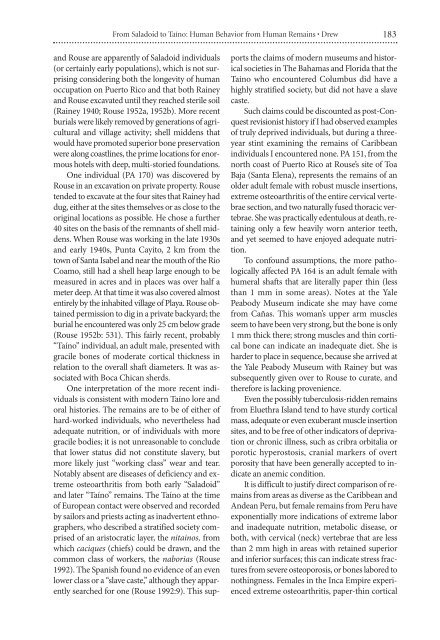You also want an ePaper? Increase the reach of your titles
YUMPU automatically turns print PDFs into web optimized ePapers that Google loves.
<strong>From</strong> <strong>Saladoid</strong> <strong>to</strong> <strong>Taíno</strong>: <strong>Human</strong> <strong>Behavior</strong> <strong>from</strong> <strong>Human</strong> <strong>Rema<strong>in</strong>s</strong> • Drew 183<br />
and Rouse are apparently of <strong>Saladoid</strong> <strong>in</strong>dividuals<br />
(or certa<strong>in</strong>ly early populations), which is not surpris<strong>in</strong>g<br />
consider<strong>in</strong>g both <strong>the</strong> longevity of human<br />
occupation on Puer<strong>to</strong> Rico and that both Ra<strong>in</strong>ey<br />
and Rouse excavated until <strong>the</strong>y reached sterile soil<br />
(Ra<strong>in</strong>ey 1940; Rouse 1952a, 1952b). More recent<br />
burials were likely removed by generations of agricultural<br />
and village activity; shell middens that<br />
would have promoted superior bone preservation<br />
were along coastl<strong>in</strong>es, <strong>the</strong> prime locations for enormous<br />
hotels with deep, multi-s<strong>to</strong>ried foundations.<br />
One <strong>in</strong>dividual (PA 170) was discovered by<br />
Rouse <strong>in</strong> an excavation on private property. Rouse<br />
tended <strong>to</strong> excavate at <strong>the</strong> four sites that Ra<strong>in</strong>ey had<br />
dug, ei<strong>the</strong>r at <strong>the</strong> sites <strong>the</strong>mselves or as close <strong>to</strong> <strong>the</strong><br />
orig<strong>in</strong>al locations as possible. He chose a fur<strong>the</strong>r<br />
40 sites on <strong>the</strong> basis of <strong>the</strong> remnants of shell middens.<br />
When Rouse was work<strong>in</strong>g <strong>in</strong> <strong>the</strong> late 1930s<br />
and early 1940s, Punta Cayi<strong>to</strong>, 2 km <strong>from</strong> <strong>the</strong><br />
<strong>to</strong>wn of Santa Isabel and near <strong>the</strong> mouth of <strong>the</strong> Rio<br />
Coamo, still had a shell heap large enough <strong>to</strong> be<br />
measured <strong>in</strong> acres and <strong>in</strong> places was over half a<br />
meter deep. At that time it was also covered almost<br />
entirely by <strong>the</strong> <strong>in</strong>habited village of Playa. Rouse obta<strong>in</strong>ed<br />
permission <strong>to</strong> dig <strong>in</strong> a private backyard; <strong>the</strong><br />
burial he encountered was only 25 cm below grade<br />
(Rouse 1952b: 531). This fairly recent, probably<br />
“<strong>Taíno</strong>” <strong>in</strong>dividual, an adult male, presented with<br />
gracile bones of moderate cortical thickness <strong>in</strong><br />
relation <strong>to</strong> <strong>the</strong> overall shaft diameters. It was associated<br />
with Boca Chican sherds.<br />
One <strong>in</strong>terpretation of <strong>the</strong> more recent <strong>in</strong>dividuals<br />
is consistent with modern <strong>Taíno</strong> lore and<br />
oral his<strong>to</strong>ries. The rema<strong>in</strong>s are <strong>to</strong> be of ei<strong>the</strong>r of<br />
hard-worked <strong>in</strong>dividuals, who never<strong>the</strong>less had<br />
adequate nutrition, or of <strong>in</strong>dividuals with more<br />
gracile bodies; it is not unreasonable <strong>to</strong> conclude<br />
that lower status did not constitute slavery, but<br />
more likely just “work<strong>in</strong>g class” wear and tear.<br />
Notably absent are diseases of deficiency and extreme<br />
osteoarthritis <strong>from</strong> both early “<strong>Saladoid</strong>”<br />
and later “<strong>Taíno</strong>” rema<strong>in</strong>s. The <strong>Taíno</strong> at <strong>the</strong> time<br />
of European contact were observed and recorded<br />
by sailors and priests act<strong>in</strong>g as <strong>in</strong>advertent ethnographers,<br />
who described a stratified society comprised<br />
of an aris<strong>to</strong>cratic layer, <strong>the</strong> nita<strong>in</strong>os, <strong>from</strong><br />
which caciques (chiefs) could be drawn, and <strong>the</strong><br />
common class of workers, <strong>the</strong> naborias (Rouse<br />
1992). The Spanish found no evidence of an even<br />
lower class or a “slave caste,” although <strong>the</strong>y apparently<br />
searched for one (Rouse 1992:9). This supports<br />
<strong>the</strong> claims of modern museums and his<strong>to</strong>rical<br />
societies <strong>in</strong> The Bahamas and Florida that <strong>the</strong><br />
<strong>Taíno</strong> who encountered Columbus did have a<br />
highly stratified society, but did not have a slave<br />
caste.<br />
Such claims could be discounted as post-Conquest<br />
revisionist his<strong>to</strong>ry if I had observed examples<br />
of truly deprived <strong>in</strong>dividuals, but dur<strong>in</strong>g a threeyear<br />
st<strong>in</strong>t exam<strong>in</strong><strong>in</strong>g <strong>the</strong> rema<strong>in</strong>s of Caribbean<br />
<strong>in</strong>dividuals I encountered none. PA 151, <strong>from</strong> <strong>the</strong><br />
north coast of Puer<strong>to</strong> Rico at Rouse’s site of Toa<br />
Baja (Santa Elena), represents <strong>the</strong> rema<strong>in</strong>s of an<br />
older adult female with robust muscle <strong>in</strong>sertions,<br />
extreme osteoarthritis of <strong>the</strong> entire cervical vertebrae<br />
section, and two naturally fused thoracic vertebrae.<br />
She was practically edentulous at death, reta<strong>in</strong><strong>in</strong>g<br />
only a few heavily worn anterior teeth,<br />
and yet seemed <strong>to</strong> have enjoyed adequate nutrition.<br />
To confound assumptions, <strong>the</strong> more pathologically<br />
affected PA 164 is an adult female with<br />
humeral shafts that are literally paper th<strong>in</strong> (less<br />
than 1 mm <strong>in</strong> some areas). Notes at <strong>the</strong> Yale<br />
Peabody Museum <strong>in</strong>dicate she may have come<br />
<strong>from</strong> Cañas. This woman’s upper arm muscles<br />
seem <strong>to</strong> have been very strong, but <strong>the</strong> bone is only<br />
1 mm thick <strong>the</strong>re; strong muscles and th<strong>in</strong> cortical<br />
bone can <strong>in</strong>dicate an <strong>in</strong>adequate diet. She is<br />
harder <strong>to</strong> place <strong>in</strong> sequence, because she arrived at<br />
<strong>the</strong> Yale Peabody Museum with Ra<strong>in</strong>ey but was<br />
subsequently given over <strong>to</strong> Rouse <strong>to</strong> curate, and<br />
<strong>the</strong>refore is lack<strong>in</strong>g provenience.<br />
Even <strong>the</strong> possibly tuberculosis-ridden rema<strong>in</strong>s<br />
<strong>from</strong> Eluethra Island tend <strong>to</strong> have sturdy cortical<br />
mass, adequate or even exuberant muscle <strong>in</strong>sertion<br />
sites, and <strong>to</strong> be free of o<strong>the</strong>r <strong>in</strong>dica<strong>to</strong>rs of deprivation<br />
or chronic illness, such as cribra orbitalia or<br />
porotic hyperos<strong>to</strong>sis, cranial markers of overt<br />
porosity that have been generally accepted <strong>to</strong> <strong>in</strong>dicate<br />
an anemic condition.<br />
It is difficult <strong>to</strong> justify direct comparison of rema<strong>in</strong>s<br />
<strong>from</strong> areas as diverse as <strong>the</strong> Caribbean and<br />
Andean Peru, but female rema<strong>in</strong>s <strong>from</strong> Peru have<br />
exponentially more <strong>in</strong>dications of extreme labor<br />
and <strong>in</strong>adequate nutrition, metabolic disease, or<br />
both, with cervical (neck) vertebrae that are less<br />
than 2 mm high <strong>in</strong> areas with reta<strong>in</strong>ed superior<br />
and <strong>in</strong>ferior surfaces; this can <strong>in</strong>dicate stress fractures<br />
<strong>from</strong> severe osteoporosis, or bones labored <strong>to</strong><br />
noth<strong>in</strong>gness. Females <strong>in</strong> <strong>the</strong> Inca Empire experienced<br />
extreme osteoarthritis, paper-th<strong>in</strong> cortical


















